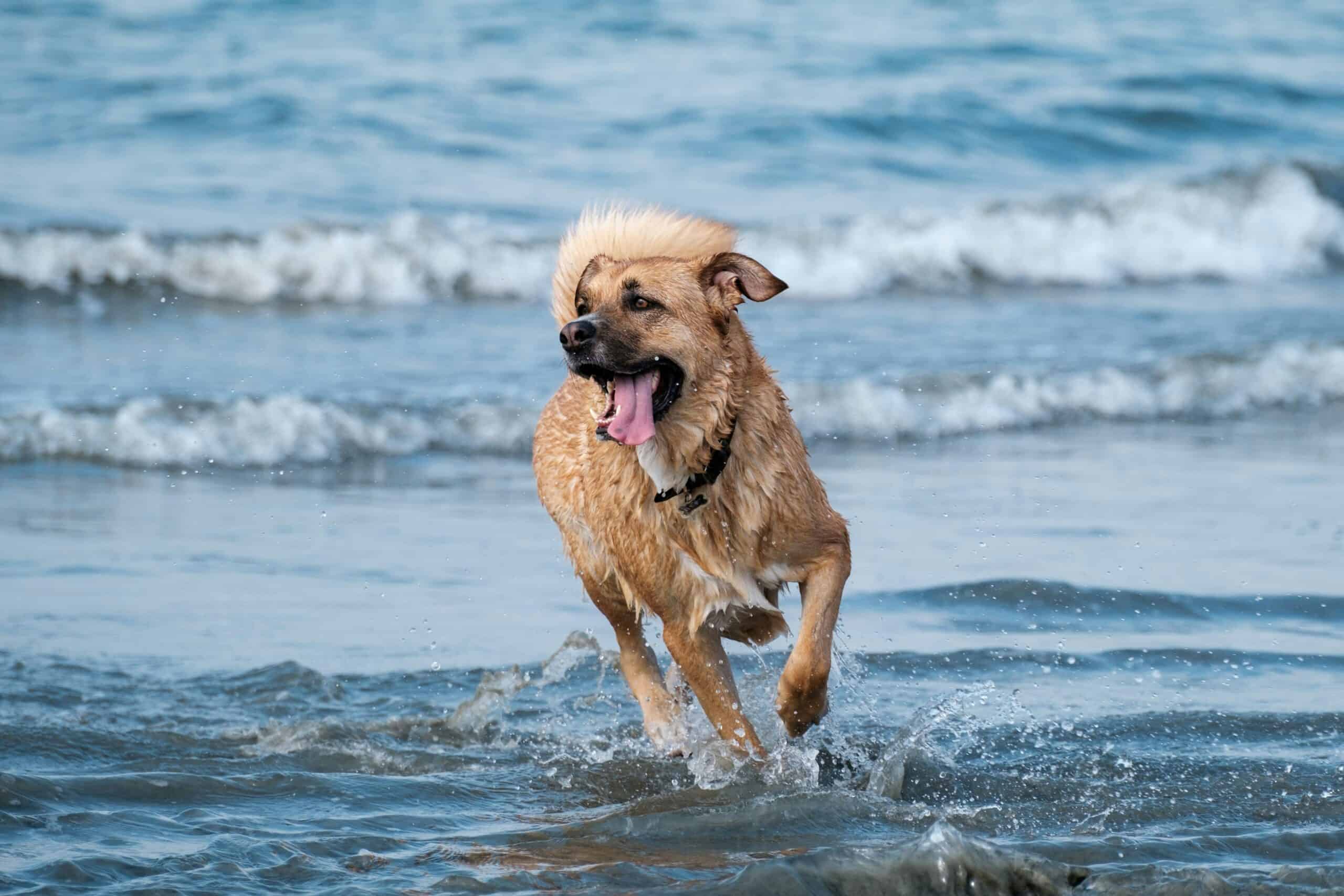Dog Water Safety: Essential Tips for the Beach, Pool, and Lake
Posted by Lora Shaw on May 10, 2024

Key Takeaways on Water Safety for Dogs
- Always supervise your dog near water and use basic commands to keep them nearby and safe.
- Equip your dog with a properly fitted life jacket, especially if they are not strong swimmers.
- Try to keep your dog away from algae-infested bodies of water to prevent any exposure to toxins.
- After swimming, rinse your dog to remove any salt, sand, or pool chemicals that may irritate their skin.
Summer is right around the corner, and this means that there are probably some days at the beach, pool, and lake in your future. You might decide to leave your furry friends at home, but since they probably enjoy the water just as much as you do, there’s a good chance they’ll be tagging along.
Whether it’s your first time taking your dog near water or you’re a seasoned pro, we wanted to give our favorite tips on dog water safety to make sure your pet’s happy and healthy both during and after the trip.
Encouraging Dog Water Safety by Understanding Hazards
Each water type can pose different hazards to your pet, and while this shouldn’t deter you from having a fun day at the beach, lake, or pool, it is important to be aware of them and take precautions. We’ve put together a list of actionable items that will help keep your dog safe in and around the water sorted by location:
Dog Water Safety at the Beach
- To keep your dog safe in the water, look for any strong currents that could carry them away and monitor your pet closely while they’re swimming
- Watch out for jellyfish, stingrays, and other marine creatures that can cause harm or discomfort to your furry friend
- Provide your dog with fresh water after swimming since saltwater and the sun can be dehydrating
- Rinse salt and sand from your dog’s coat to prevent skin irritation
- Consider using a pet-safe sunscreen on parts of your dog with less fur like the nose, ears, and belly
- Walk your dog on cooler surfaces to protect their paws from heat-related injuries while on the beach
The Pool
- Supervise your dog near the pool at all times to monitor their well-being
- Teach your dog to exit the pool safely using the stairs
- Rinse your pup off after their time in the pool to prevent them from having irritation from chemicals in the water
- Make sure the barrier around the pool is locked when not in use to prevent your dog from accessing the area without supervision
The Lake
- Avoid letting your dog in stagnant water because it can harbor bacteria and make your dog sick
- Stay away from areas that have algae blooms and rinse your dog thoroughly if they do make it into a lake where algae is present
- Understand boating safety if you are going out on the water and teach your dog how to safely enter and exit the boat
- Put your dog in a well-fitted life jacket that can keep them afloat if needed
Our Favorite Tips for Dog Water Safety
When it comes to keeping your dog safe in the water, there are a few rules to follow. Since no dog is the same, the rules may vary for each family, but we wanted to compile a full list to ensure that you have all of your bases covered.
Here are our favorite tips for dog water safety:
- Research life jackets – Invest in a well-fitted life jacket for your pup if they are not strong swimmers or if you plan on keeping them in the water for long periods of time. This is especially key if you’re going to be spending the day in the water, on a boat, or in an area where there could be unexpected waves or currents. Additionally, this approach may be particularly beneficial for older dogs who still love the water but don’t have the energy they used to as a puppy.
- Train your pup – Before taking the trip to your local beach or pool, make sure your dog understands basic commands like “come,” “stay,” “sit,” “heel,” and others to ensure that they will listen in case of an emergency.
- Provide fresh drinking water – Always provide fresh water for your dog to prevent them from drinking saltwater or chlorinated water from pools, which can give them a stomachache and result in dehydration.
- Supervise – To keep your dog safe around water, never leave them unattended. Even if they are known to be strong swimmers, it’s still important to watch them.
- Watch for signs of fatigue – Keep an eye out for signs of fatigue like excessive panting, lagging behind, or difficulty staying afloat. Just like humans, dogs need to take a break from treading water, so let them do just that!
- Rinse after swimming – Rinsing your dog off with a hose or giving them a bath is always nice after they’ve spent the day in chlorine or saltwater. This helps remove any residue from their coat and can prevent irritation and dryness.
FAQs About Keeping Your Dog Safe Around the Water
Are all dogs able to swim?
Dog water safety 101 starts with an analysis of your pup’s swimming skills. Many dogs can swim instinctively, but not all are going to be strong swimmers. Dogs that have short legs or heavy bodies may struggle a bit in the water, making it that much more important to get them a life vest or a different floatation device.
Additionally, there are dogs who may not enjoy swimming or have a fear of the water, so be sure to test your dog’s preferences before planning an entire day in the water with them.
Is it safe for my dog to drink water from oceans, pools, and lakes?
To keep your dog safe and healthy, it’s best to discourage them from drinking water from these sources. Ocean water contains salt which is dangerous for any mammal to drink, and pool water contains chlorine and other chemicals, which are dangerous in larger doses as well. Plus, oceans, pools, and lakes may contain harmful bacteria or parasites that can harm your pet. Therefore, it is always important to provide fresh water for them.
Can I let my dog swim off-leash?
Whether you allow your dog to swim off-leash depends heavily on the area and your dog’s abilities. When in open water areas, keeping your dog on a leash can prevent them from getting into dangerous situations or wandering off.
What are the signs of water intoxication in dogs?
We’d like to conclude our dog water safety FAQs by talking about water intoxication. This phenomenon occurs when a dog ingests an excess of water, causing an imbalance of electrolytes in the body. Here are the signs to look out for:
- Excessive water consumption (this may seem obvious, but if your dog is drinking an abnormally high volume of water in a short period of time it is a sign to look out for)
- Nausea and vomiting
- Lethargy and weakness
- Excessive drooling or salivation
- Bloating of the abdomen
- Pale gums and mucous membranes
- Disorientation or confusion
If you’re noticing these signs in your dog after a long day in the sun, it’s important to contact your vet and ensure that your dog is healthy.
Contact Us for Dog Day Care and Boarding!
If there is ever a time when you want to get out and enjoy the water without your pup, or if they are not a fan of the water, the team at Pet Palace is happy to step in and watch them! We have the best dog boarding and day care in the business.
Contact us today to schedule an appointment!

Categories: All Posts, Dogs, Tips for Your Pets
Archives
Recent Articles
Categories
Monthly Archive
- April 2025
- March 2025
- February 2025
- January 2025
- December 2024
- November 2024
- October 2024
- September 2024
- August 2024
- July 2024
- June 2024
- May 2024
- April 2024
- March 2024
- February 2024
- January 2024
- December 2023
- November 2023
- October 2023
- August 2023
- July 2023
- June 2023
- May 2023
- April 2023
- March 2023
- February 2023
- January 2023
- December 2022
- November 2022
- October 2022
- August 2022
- July 2022
- June 2022
- April 2022
- March 2022
- February 2022
- November 2021
- October 2021
- November 2020
- September 2020
- July 2020
- March 2020
- January 2020
- November 2019
- September 2019
- July 2019
- March 2019
- January 2019
- December 2018
- November 2018
- October 2018
- August 2018
- July 2018
- June 2018
- May 2018
- April 2018
- March 2018
- February 2018
- January 2018
- December 2017
- November 2017
- October 2017
- September 2017
- August 2017
- July 2017
- June 2017
- May 2017
- April 2017
- March 2017
- February 2017
- January 2017
- December 2016
- November 2016
- September 2016
- August 2016
- July 2016
- June 2016
- May 2016
- April 2016
- March 2016
- February 2016
- December 2015
- November 2015
- October 2015
- September 2015
- August 2015
- July 2015
- May 2015
- March 2015
- February 2015
- January 2015
- December 2014
- November 2014
- September 2014
- August 2014
- July 2014
- June 2014
- May 2014
- March 2014
- February 2014
- January 2014
- December 2013
- November 2013
- October 2013
- September 2013
- August 2013
- June 2013
- May 2013
- March 2013
